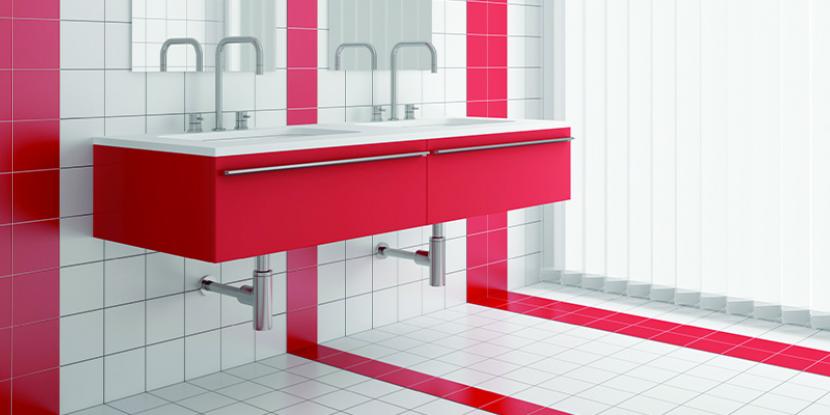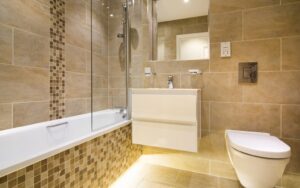Nothing compares to the feeling of entering a restroom that is as clean as a place created around hygiene and cleanliness should be. However, constructing a genuinely clean bathroom might seem overwhelming at times…and keeping it clean can feel closer to the “impossible” end of the intimidating scale. Especially tile and grout in bathrooms. With spring cleaning in the air, there are some tips and methods for cleaning and maintaining bathroom tiles.
Everyday, clean a little portion of the bathroom.

This does not imply that you should deep-clean the bathroom on a daily basis. Rather than that, it involves doing daily minor, 20-second activities such as spot-cleaning the mirror or floor bathroom tiles and washing down the worktops, tile backsplash, and/or sink. However, you should do the following bathroom cleaning recommendations on a weekly basis. However, if you do it weekly, you’ll see that it becomes simpler and you get more efficient.
Vacuum the bathroom tiles.
While sweeping and mopping are fine, there are times when the strong suction of a vacuum cleaner is required to remove hair and dirt from bathroom tiles, whether on the floor or on the wall.
Prepare the bathroom tiles by preheating it.
When feasible, adjust the faucet to the warmest water setting and fill the bathtub and sink halfway with hot water to warm the surrounding regions. Additionally, splash some hot water over difficult tile areas. Allow a few minutes for them to rest while you clean the mirror or wash off other surfaces. Then drain the hot water and clean the surrounding bathroom tiles and area; increasing heat has been shown to dramatically boost alkaline cleaner efficacy.
Begin from the top and work your way down.

If your bathroom has tile as a tub surround, a backsplash, or on the floor, you’ll want to start at the top and work your way down. Spray the antibacterial cleanser liberally throughout, then scrub from the top down. This improves the effectiveness of your cleaning session by preventing cleaner and filth from flowing down and landing on previously cleaned areas.
Distribute the cleanser uniformly.
When cleaning tile, you’ll want to uniformly distribute the bathroom tiles cleaner (including any DIY natural tile or grout cleaner) throughout the tile and grout. This is most successfully accomplished with a sponge or soft cloth.
The majority of bathroom tiles cleaners (and other cleaners) perform best when given a few minutes to settle and battle the filth on the tile itself. Resist the impulse to begin swiping the cleaner away immediately after spraying and spreading it. Allow about five minutes for the cleaning capacity to fully activate.
Scrub all exposed surfaces.
After around five minutes, it’s time to scrub your bathroom tiles clean. While tile surfaces vary in hardness, grout is more porous, so be careful to scrub using a non-abrasive instrument, such as a gentler scrub brush or non-scratch pad. Additionally, if being green with your cleaning is a priority, you might investigate utilizing natural substances to clean grout.
Consider using a Magic Eraser.
If you’re serious about learning how to clean bathroom tiles, we suggest experimenting with a detergent you trust on your most tough tile and porcelain surfaces. While this method is less successful on grout, it works wonders on the smoother surfaces of tiles.
Rinse all cleaners well.
You don’t want to undo all of your hard work cleanings by leaving chemicals on the surfaces of your bathroom tiles, so completely rinse them after washing.
All surfaces should be completely dry.
Particularly on the floor, where a damp floor represents a significant safety danger, you’ll want to fully dry all surfaces. Consider using color-coded dry rags (for example, red rags for the floor, yellow rags for the toilet, and blue rags for the sink) to prevent cross-contamination of possibly lingering surface germs.
How to clean tile grouting
Let’s begin by learning how to properly clean in between the bathroom tiles. Discolored grout may make your tiles seem dirtier than they really are, and the porous structure of the majority of grouting makes it very prone to harmful bacteria and mold development. The best method for cleaning unclean grout is to use an old toothbrush and your preferred cleaning chemical.
While others swear by a baking soda-vinegar solution, more difficult grout stains – and hence more effective cleaning – need a purpose-built product like the Harpic Bathroom Cleaner. The Harpic Bathroom Cleaner is a superior alternative to detergent or phenyl-based cleaners, which may be ineffective against difficult stains. So that you know precisely what to do, read up on how to use the Harpic Bathroom Cleaner.
Whichever cleaner you select, the methods are almost identical:
Step 1 – Apply the cleanser as directed on the package to the afflicted areas.
Step 2 – Using the toothbrush, scrub aggressively.
Step 3 – Allow the solution to work its magic for a few minutes.
Step 4 – Rinse everything thoroughly with clean water
Step 5 – Repetition as necessary
Finally, wipe clean your tiles with a microfiber towel to avoid streaks.
What is the best way to clean bathroom tiles?
After tackling the floor bathroom tiles, the next step is determining how to clean wall bathroom tiles. Once again, a purpose-built cleaner is your best choice, since it will include disinfecting properties in addition to the ability to remove even the most stubborn stains.
Before you begin, read the manufacturer’s directions on the cleaner’s label. Before beginning, you may be advised to dilute the cleaner with water, although certain cleaners perform best undiluted. Never use a cleanser undiluted if the directions state that it should be diluted. Click here to know more about tiles and baths for your home.
Again, the steps are straightforward:
Step 1 – Steam your bathroom to pre-warm your wall bathroom tiles.
Step 2 – Apply your selected cleaner to the tiles, working in small chunks at a time.
Step 3 – Using a soft sponge, mild pressure, and a steady wiping motion, scrub the tiles.
Step 4 – Allow the solution to dry for 5 minutes on the bathroom tiles.
5 – Rinse thoroughly with clean water
Step 6 – If necessary, repeat
Step 7 – Using a microfiber towel, dab the walls dry to avoid stains.


